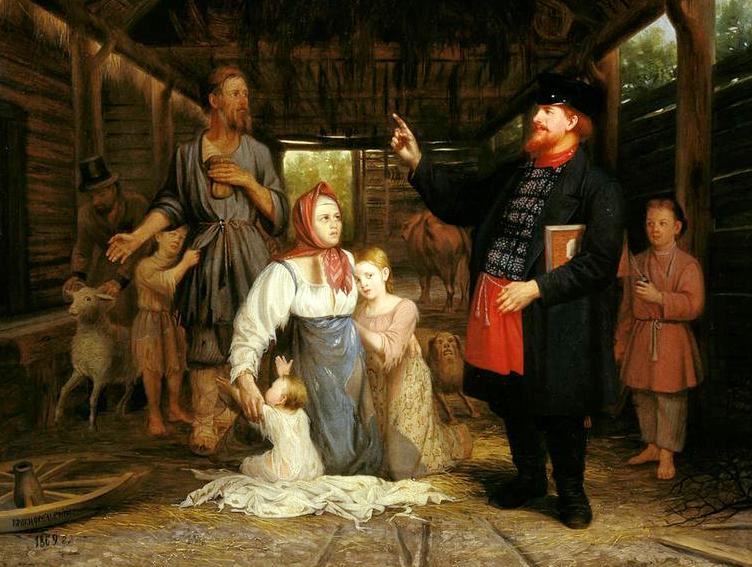
Russian Serfdom: Lingering Impact

Figure 1.--This painting by Alexander Krasnoselsky was entitled 'Debt collection' and painted in 1869. We know next to nothing about the artist. Tsar Akexander II liberated the serfs. Most got small plots of land, but had to pourchase their freedom. This neant that most were left heavily indebted. As a result, their situation was not dramatically improved and as a result, Tsarist Russia's problems remaimed unresolved.
|
|
Emancipation did not solve Russia's fundamental problems. The cindition of the serfs were not fundamentally changed. Some of the worse abuses were ended, but the serf'a basic economic condition was not radically changed. They had the promise of real land ownership, but only very small plots and were mired deeply in debt to acquire that. The landowners still benefitted from the lionshare of the production of their estates which meant that there was still no incentice for investing in more efficent farming methods that would have released increased production and help finance industruilization as well as release labor for industry. Maintaining inefficent methods in the all important gruculturl sector reduced the output of the economy at a time that other countries were not only industrialising but increasing agricultural output. More than anything, the Russians were poorly utikizing their human capital in sharp contrast to Western Eurioe, especially the Germans. It is not that Russia did not begin to industrislize. By the turn of the century, industrial growth was impressive, but had not matched German industry. Politically the relative stability in the countryside and supoport of the aristicracy allowed the sarist regime to maintain an absolutist system. This meant that any political opposition was illegal and grave rise to radical conspiratorial groups. Even middle-class Germans bcame involved because of the Tsarist regime's resistance to moderate democratic reforms. Untimately the most radical grouo, skilled in conspiratorial organization, the Bolsheviks, would seize power.
CIH

Navigate the Children in History Website:
[Return to the Main Ryussian serfdom: Historical development page]
[Return to the Main Russian serfdom page]
[Return to the Main later serfdom page]
[Return to the Main serfdom page]
[Return to the Main forced labor page]
[About Us]
[Introduction]
[Biographies]
[Chronology]
[Climatology]
[Clothing]
[Disease and Health]
[Economics]
[Freedom]
[Geography]
[History]
[Human Nature]
[Ideology]
[Law]
[Nationalism]
[Presidents]
[Religion]
[Royalty]
[Science]
[Social Class]
[Bibliographies]
[Contributions]
[FAQs]
[Glossaries]
[Images]
[Links]
[Registration]
[Tools]
[Children in History Home]
Navigate the Historic Boys' Clothing Russian pages:
[Ballet]
[Choirs]
[Movies]
[Royalty]
[School uniform]
[Youth groups]
Navigate the Children in History ebsitee:
[Return to theMain Russian enserment of the peasantry page]
[Return to theMain Russian country page]
[Kazakhstan]
[Kyrgyzstan]
[Tajikistan]
[Turkmenistan]
[Uzbekistan]
[Bulgaria]
[Czechoslovakia]
[Estonia]
[Finland]
[Germany]
[Latvia]
[Lithuania]
[Poland]
[Romania]
[Russia]
[Armenia]
[Azerbaijan]
[Georgia]
[Turkey]
[Canada]
[United States]
Created: 6:12 AM 7/27/2018
Last updated: 6:12 AM 7/27/2018



